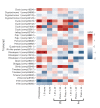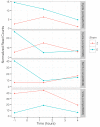Non-Pleiotropic Coupling of Daily and Seasonal Temporal Isolation in the European Corn Borer
- PMID: 29587435
- PMCID: PMC5924522
- DOI: 10.3390/genes9040180
Non-Pleiotropic Coupling of Daily and Seasonal Temporal Isolation in the European Corn Borer
Abstract
Speciation often involves the coupling of multiple isolating barriers to produce reproductive isolation, but how coupling is generated among different premating barriers is unknown. We measure the degree of coupling between the daily mating time and seasonal mating time between strains of European corn borer (Ostrinia nubilalis) and evaluate the hypothesis that the coupling of different forms of allochrony is due to a shared genetic architecture, involving genes with pleiotropic effects on both timing phenotypes. We measure differences in gene expression at peak mating times and compare these genes to previously identified candidates that are associated with changes in seasonal mating time between the corn borer strains. We find that the E strain, which mates earlier in the season, also mates 2.7 h earlier in the night than the Z strain. Earlier daily mating is correlated with the differences in expression of the circadian clock genes cycle, slimb, and vrille. However, different circadian clock genes associate with daily and seasonal timing, suggesting that the coupling of timing traits is maintained by natural selection rather than pleiotropy. Juvenile hormone gene expression was associated with both types of timing, suggesting that circadian genes activate common downstream modules that may impose constraint on future evolution of these traits.
Keywords: allochronic isolation; circadian clock; gene expression; sexual behavior; speciation.
Conflict of interest statement
The authors declare no conflict of interest.
Figures






Similar articles
-
Components of reproductive isolation between North American pheromone strains of the European corn borer.Evolution. 2010 Apr 1;64(4):881-902. doi: 10.1111/j.1558-5646.2009.00883.x. Epub 2009 Nov 6. Evolution. 2010. PMID: 19895559 Free PMC article.
-
Genomic Basis of Circannual Rhythm in the European Corn Borer Moth.Curr Biol. 2019 Oct 21;29(20):3501-3509.e5. doi: 10.1016/j.cub.2019.08.053. Epub 2019 Oct 10. Curr Biol. 2019. PMID: 31607536
-
Genetic basis of allochronic differentiation in the fall armyworm.BMC Evol Biol. 2017 Mar 6;17(1):68. doi: 10.1186/s12862-017-0911-5. BMC Evol Biol. 2017. PMID: 28264650 Free PMC article.
-
Phenology-dependent cold exposure and thermal performance of Ostrinia nubilalis ecotypes.BMC Evol Biol. 2020 Mar 6;20(1):34. doi: 10.1186/s12862-020-1598-6. BMC Evol Biol. 2020. PMID: 32138649 Free PMC article.
-
Sexual conflict and speciation.Philos Trans R Soc Lond B Biol Sci. 1998 Feb 28;353(1366):261-74. doi: 10.1098/rstb.1998.0208. Philos Trans R Soc Lond B Biol Sci. 1998. PMID: 9533125 Free PMC article. Review.
Cited by
-
bric à brac controls sex pheromone choice by male European corn borer moths.Nat Commun. 2021 May 14;12(1):2818. doi: 10.1038/s41467-021-23026-x. Nat Commun. 2021. PMID: 33990556 Free PMC article.
-
Standing geographic variation in eclosion time and the genomics of host race formation in Rhagoletis pomonella fruit flies.Ecol Evol. 2018 Dec 14;9(1):393-409. doi: 10.1002/ece3.4758. eCollection 2019 Jan. Ecol Evol. 2018. PMID: 30680122 Free PMC article.
-
Divergence in cell cycle progression is associated with shifted phenology in a multivoltine moth: the European corn borer, Ostrinia nubilalis.J Exp Biol. 2023 Jun 1;226(11):jeb245244. doi: 10.1242/jeb.245244. Epub 2023 Jun 9. J Exp Biol. 2023. PMID: 37293992 Free PMC article.
-
Elevated temperature increases reproductive investment in less preferred mates in the invasive European corn borer moth.Ecol Evol. 2021 Aug 4;11(17):12064-12074. doi: 10.1002/ece3.7972. eCollection 2021 Sep. Ecol Evol. 2021. PMID: 34522361 Free PMC article.
-
Variation in chronotype is associated with migratory timing in a songbird.Biol Lett. 2019 Aug 30;15(8):20190453. doi: 10.1098/rsbl.2019.0453. Epub 2019 Aug 28. Biol Lett. 2019. PMID: 31455169 Free PMC article.
References
-
- Coyne J.A., Orr H.A. Speciation. Volume 37 Sinauer Associates; Sunderland, MA, USA: 2004.
LinkOut - more resources
Full Text Sources
Other Literature Sources

